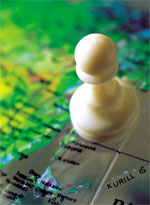Big 'D' vs. Small 'd'
 In his analysis of the role of language in society, Gee argues that language has uses that go beyond common use of conveying information (Gee, 2003). Language is a tool that people use to situate action by giving context-specific meanings to actions and to the objects involved in those actions.
In his analysis of the role of language in society, Gee argues that language has uses that go beyond common use of conveying information (Gee, 2003). Language is a tool that people use to situate action by giving context-specific meanings to actions and to the objects involved in those actions.
Language also is used to convey perspectives by giving others "alternative ways to view one and the same state of affairs" (Gee, 1999). To study how language works, he developed the concepts of little "d" and big "D" discourse.
With little "d" discourse, he refers to the analysis of specific instances of language-in-use.
Big "D" Discourse, on the other hand, refers to ways of thinking, acting, doing and being in the world.
Discourses can be thought of as identity kits that exist in the social context of the groups that affiliate with such identities. This entails a view of learning as the gradual adoption by learners of the practices, specialist language and ways of thinking associated with a discourse.
Discourses, even though a useful analytic device, are not static and well defined; on the contrary, discourses tend to overlap over each other. In social games like Second Life,members can shift the shapes, looks and ways of their avatar according to specific groups. These groups are usually organized in "physical" areas, called parcels or islands, in the virtual world on which group members gather. As such, a player may belong to the Puppy Lover group in one area, be a member of the Animal Rights group in another area, and belong to a third hybrid group that loves puppies and fights for their rights.
Blurring the boundaries between "the virtual" and " the real"

Because of the inherent interplay between identities that takes place in MMOs, it sometimes becomes difficult for players to distinguish where the virtual world ends and where the real one begins. From the group of players that can do nothing but talk about their World of Warcraft experiences at home to the augmented reality games that superimpose virtual images over the real world, this blurring of identities can bring multiple opportunities for transferring knowledge learned in the virtual world out to the real one and vice versa.
An example of a game that attempts this model is Quest Atlantis (QA). In QA, students involved in the virtual world explore a set of complex problems related to environmental science. The goal of their quest is to come up with a defensible explanation for why the fish in a river are dying. In order to do so, students must gather information from characters in the virtual world.
However, even more powerful is the fact that part of the assignments they are given by the characters is to go out to the real world and collect information from locations or people that will help them complete their quest back in the virtual space. It is in this blurring of boundaries that transfer of knowledge to the real world is facilitated.
